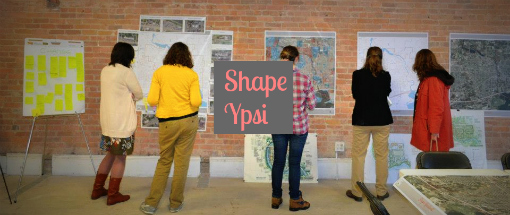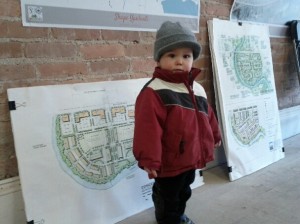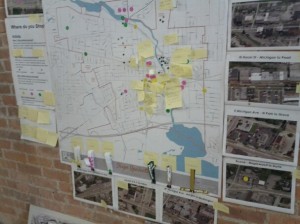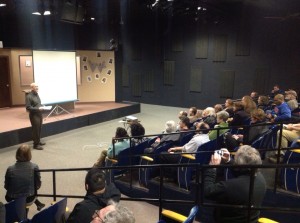The people of Ypsilanti are currently going through the process of rewriting the City’s Master Plan. The exhaustive undertaking, which has been constructed in such a way as to incorporate the input from as many community members as possible, is already well under way, but, over the coming months, there will still be ample opportunities for folks to engage and contribute their ideas. In hopes of finding out more about the process, I reached out to Ypsilanti City Planner Teresa Gillotti, and Ypsilanti City Planner Emeritus Richard Murphy, who currently serves on the Steering Committee which has been charged with seeing the undertaking, which has been dubbed “Shape Ypsi,” through to completion. Here’s our exchange.

MARK: First, let’s start with what a Master Plan is, and why the city needs one. I think I know the answer, but I’m curious as to what you’ll say.
TERESA: The Master Plan is the guiding document for the city’s next 10-20 years. Practically, it’s something that I use frequently, as do others, to make sure that the projects we take on are in-line with the community’s vision as to where the City should be heading. The implementation tool of the Master Plan is the zoning ordinance, and that revision will follow the drafting of a new Master Plan… I think it’s important for Ypsilanti, especially now that we’ve gone through de-industrialization, and both a housing boom and bust. There are questions as to where we want go, in terms of our economy, our neighborhoods, and the transportation options available to us. In a time of diminishing resources, it’s still important to make deliberate choices, and to build on the existing physical infrastructure and our community character, which is Ypsilanti’s greatest strength. Ypsi is growing and changing, and sticking with the current plan, and the zoning requirements which were drafted to support it, limits where we can go. It’s time to rethink and redefine the City’s direction together as a community.
MARK: Are Master Plans required by law? Are there communities without them?
TERESA: The State of Michigan Planning Enabling Act requires the State’s Planning Commissions to develop and adopt a Master Plan, as well as update it every 5 years.
MARK: When did we last go through this process? Was it at all contentious? If so, why?
TERESA: The last time the process happened was in the late 1990s. (Our current plan, which was largely written in 1998, can be found here.) I don’t know the details of the process… maybe folks can discuss it in the comments section. I do know that, with most large-scale zoning changes, there is often concern as folks try to stay abreast of changes that might impact their neighborhoods, properties and commercial districts. After the Master Plan is adopted, the next stage is to move toward a major zoning ordinance revision, and a “form based code.” I expect that will also draw attention and opinions. I’m hoping for creativity and exploration, although I know sometimes it’s easy to take on a defensive posture when it comes to potential changes to one’s own property.
 MARK: I’m not familiar with the phrase, “form based code.” What’s that?
MARK: I’m not familiar with the phrase, “form based code.” What’s that?
MURPH: A “form based code” is a zoning ordinance that focuses most of its attention on the physical aspects of a building and site — how big is it, where is it relative to the street and sidewalk and neighboring properties, how much parking does it have — and spends less time listing the uses that are permitted or prohibited on the site. The form-based approach has gained in popularity in recent years as a way to focus regulations on the aspects of development that have the greatest impact on community character, and reducing the amount of micromanaging of what types of businesses can exist in a particular building.
MARK: Thanks, Murph. That makes more sense…. Earlier, Teresa, you mentioned that Michigan law requires that we update the Master Plan every five years. Is it safe to assume that, while we haven’t rewritten ours from scratch in some time, we have made edits to reflect changing circumstances? Assuming that’s the case, I’m curious to know what the most recent changes have been.
TERESA: In 2008, the City amended the Water Street area plan, and, in 2010, the City amended the Master Plan to include the Non-Motorized Transportation Plan. No overall update has been completed since 1998, though.
MURPH: We’ve done small amendments as individual developments came up, too — when Ave Maria closed their campus on Forest Avenue, for example, we had to amend the plan’s “future land use map” to allow anything other than an institutional use there.
MARK: How do people, if they want to engage in the process, go about doing so?
TERESA: This week, we’re in the Discover Charette phase of the process, and there are a number of events taking place. It’s essentially a week-long workshop that started with a Community Conversation on Tuesday night. (Thanks to the 50-some folks who attended!) Then, on Wednesday, and again today, we had the studio open at 206 West Michigan Avenue for people to drop in and give us their ideas and opinions as to what to preserve, change or create in the City. There were posters with questions related to our various housing and commercial areas, with the intention of getting the community to weigh in on what’s working and what’s not. And, on Friday, we’ll be reporting back what we’ve learned – showing images of what things currently look like, and sharing ideas as to where we’ll go from here. That will be at 5:00 PM, at SPARK East… Then, we do it again in April at the Design Charette. There, the planning team will have examples and sketched-out scenarios for people to respond to. We’ll have a public meeting to start it, another studio event, and other neighborhood meetings similar to what’s happening this week, wrapping up with another Friday presentation. We’ll keep the website up-to-date on the details.
MARK: Have we done what you would consider a good job of benchmarking other cities? I’m curious to know if, in the process of doing so, we’ve come up with any ideas that might be worth considering here? For instance, I didn’t read it yet, but a friend sent me an article awhile ago about an ordinance that was passed somewhere on the west coast that made it easier to construct secondary housing units on one’s property, as a way of increasing density, etc. If I’m not mistaken, the article made the case that doing so proved to be incredibly beneficial for the community in question. I’m not suggesting that we do that specifically, but I’m curious as to how broadly we’re casting our net. Is everything on the table?
 TERESA: This is where our planning team comes in. They’ve done work in Michigan and the Midwest, as well as Florida, Vancouver (where everything is lovely), and tons of other places. We get to rely on their experience, and, yes, everything is on the table. In focus groups, and already this week, we’ve talked about travel lane conversions, roundabouts (what?), development in and around Depot Town, dinosaurs on the Water Street Trail, relocating the Ypsi bus terminal, the reuse and new development on the old Boys and Girls Club site on Park Street, and and that’s just what’s at the top of my mind after a long day of talking with folks. Planning out 10-20 years gives us more room to shape the city in ways as simple as making available more uses in downtown districts to encourage more business, to rethinking our street network, and imagining reuse scenarios for underutilized sites. Someone suggested a rollercoaster today – not sure where that will go – but yes, bring the ideas.
TERESA: This is where our planning team comes in. They’ve done work in Michigan and the Midwest, as well as Florida, Vancouver (where everything is lovely), and tons of other places. We get to rely on their experience, and, yes, everything is on the table. In focus groups, and already this week, we’ve talked about travel lane conversions, roundabouts (what?), development in and around Depot Town, dinosaurs on the Water Street Trail, relocating the Ypsi bus terminal, the reuse and new development on the old Boys and Girls Club site on Park Street, and and that’s just what’s at the top of my mind after a long day of talking with folks. Planning out 10-20 years gives us more room to shape the city in ways as simple as making available more uses in downtown districts to encourage more business, to rethinking our street network, and imagining reuse scenarios for underutilized sites. Someone suggested a rollercoaster today – not sure where that will go – but yes, bring the ideas.
MARK: I’m reminded of the situation a few years ago when EMU made a move to close College Place, one of the main thoroughfares which connects the University with the City. I don’t recall if, in the ensuing debate, the Master Plan was ever invoked, and that makes me wonder if it has teeth. I guess what I’m asking is, how enforceable is the Master Plan?
TERESA: That was part of a neighborhood plan that I don’t believe was ever formally adopted. The teeth of any Master Plan is the subsequent zoning ordinance, and community by-in. If people are included in the plan, and invested in the process, then, in addition to the ordinance, their support and encouragement to move forward will keep it active and relevant.
MARK: What are some of the more ambitious ideas that have come to the surface so far? Is anyone pushing for a downtown garbage incinerator, or zoning changes that would allow for a Water Street hog processing plant? Is anyone advocating for the selling of public park space? Has anyone argued for the lessening of historic district standards?
MURPH: I haven’t heard anything shocking — apparently I missed the dinosaur rollercoasters. There was some talk about reconfiguring the Cross & Washtenaw intersection, to put the water tower at the center of a roundabout; a lot of talk about turning the one-way streets into two-ways (the traffic engineers seem to think this is realistic); consolidating all the tobacco and medical marijuana businesses and the Vu into a vice district; generating all of our own energy in town. Strong support for getting a burrito place in town.
MARK: I imagine one of the major drivers behind the drafting of this new Master Plan is our desire to make something happen on Water Street. What, specifically, are the major issues, as you see them, which need to be addressed relative to that particular 38-acre downtown parcel?
TERESA: It has less to do with Water Street than it does making relevant an out-of date plan that had no direction for redeveloping a former industrial properties (the former Ford plant), no concept of our housing needs post housing crisis and with higher unemployment impacting our neighbors’ abilities to keep their homes. It doesn’t talk about addressing inequities that exist within the community, and it doesn’t speak well of managing and building off our natural resources or any of the legs of the sustainability table. The current plan was revised to address redevelopment of Water Street a few years ago, and Water Street is important, but so is addressing difficulty of pedestrians to get from EMU to downtown due to traffic flying through town. The Master Plan is bigger than any one piece.
But you didn’t quite ask me that. The community worked together on a full plan for Water Street in 1999. That resulted in Biltmore’s proposal for the site, and later Freed’s in 2006. It’s fine that today we’re willing to sell off portions of the site, as a developer would, to construct in phases. What’s tricky is that we don’t have a clear picture as to how we should guide that development. The City needs to set the stage with an idea of the form we’re looking for on the site, how to provide the infrastructure, and a clear process for seeking and guiding developers through construction. Currently staff can’t say to a developer – “Yes, we want that type of development in that location.” Every aspect is up for negotiation, almost to the point where the community has to convince itself each time that this is a good idea. (And you can interpret that to be a single project or the whole Water Street idea.) We know Water Street has baggage, and it will never be perfect. Nonetheless, we have to have a direction. It can’t be, “I’ll know it when I see it.” We have to find a direction and then we all have to get out of the way and make it happen.
MARK: What are the most common complaints you hear about the current Master Plan?
TERESA: Mainly that it doesn’t seem to reflect the creative, active community we have now… Which doesn’t mean that it failed. It just means it’s time for us to take the next step.
MURPH: The Master Plan is supposed to provide policy guidance to the Planning Commission especially as we consider zoning amendments or applications that we have some discretionary role in. Looking at it from 15 years later, I see the 1998 Master Plan as focused on “clean up”, on dealing with the sore thumbs and nuisance issues in various neighborhoods. For one thing, I think the city has achieved a lot of those goals–closing nuisance businesses that were operating illegally; getting dangerous buildings torn down or fixed up; etc.–and can focus less on those issues. The other side of this is that, since the plan focused on the details of what we had at the time, it didn’t provide much guidance for other developments: there’s no indication in the 1998 plan of what should be done with the old Ford/Visteon/ACH property, for example, because the plant was operating at the time and didn’t seem to be a concern. Similarly, when we undertook zoning ordinance amendments to more clearly permit arts-based businesses in town, there was nothing in the Master Plan that gave useful guidance on this.
I’d like to see our new master plan provide a better policy framework for things that aren’t anticipated at the time of the plan: rather than a checklist of “do this, then do this, then do this”–the old plan has several hundred very detailed recommendations about individual properties or specific programs–we need guidelines for how to approach various situations that we can’t anticipate. We’ll still have specific action steps in the new plan, but I like the starting point of talking about our values as a community, because these are higher-level things that can be applied when considering unforeseen things that come in front of us.
MARK: And this whole process is being called “Shape Ypsi,” which, to me, sounds like a local women’s gym franchise… but I suspect you’ve been hearing that a lot.
 TERESA: I thought that myself, but most people have been kind enough not to say it. In our focus groups, we’ve been literal, giving folks playdough with which to reimagine the “shape” of Ypsilanti. I have been impressed by clock towers and tridges. There was also a castle (they were trying to convey that there were too many moats), an “elephant in the room,” and a Water Tower. I was surprised that we only had one of those.
TERESA: I thought that myself, but most people have been kind enough not to say it. In our focus groups, we’ve been literal, giving folks playdough with which to reimagine the “shape” of Ypsilanti. I have been impressed by clock towers and tridges. There was also a castle (they were trying to convey that there were too many moats), an “elephant in the room,” and a Water Tower. I was surprised that we only had one of those.
MARK: I like that the website which has been launched to accompany the process allows for people to post questions. So far, though, there aren’t that many. I liked the comment from the person who wanted to suggest that we not pursue a local rail stop, as it would act as a portal, allowing nefarious Detroiters a way to enter Ypsilanti, as though they couldn’t find their way here by car, or some other form of conveyance.
TERESA: That was our first comment on the website! The second comment at Tuesday’s meeting, was about the problem of public urination, something I clearly haven’t thought about enough… We slowed down on the online questions once we started the focus groups, but I have a feeling that, after this week, we’ll put up a few more. Or, maybe you could give us suggestions on what we’ve yet to ask that needs to be asked.
MARK: How are things ultimately decided on? Does the Steering Committee vote on what’s included? And, once they’re done with the document, does it get voted on by City Council? Is there a process by which members of City Council members can then advocate for changes? Also, as I mentioned the Steering Committee, who’s been appointed to serve on it?
TERESA: The Steering Committee was formed by the Planning Commission. They ultimately will adopt the plan, but only after City Council approves release of the Master Plan to other communities for review (per state ordinance). The Steering Committee is guiding the process overall and will continue to work on outreach and championing the process and ultimate plan, as we hope other people in town will including City Council as well.
 Here’s the Steering Committee:
Here’s the Steering Committee:
Ricky Jefferson (City Council, Ward 1)
Pete Murdoch (City Council, Ward 3)
Rod Johnson (Chair, Planning Commission)
Richard Murphy (Vice Chair, Planning Commission)
Phil Hollifield (Planning Commission)
D’Real Graham (Recreation Commission)
Anne Stevenson (Historic District Commission)
Leigh Greden (EMU administration)
Desmond Miller (EMU student government)
Bee Roll (Business owner)
Teresa Gillotti (Planning staff)
MARK: What are some of the issues being raised in the focus group process that you hadn’t anticipated?
TERESA: A few times people suggested that a guiding value should be fun. I really like that notion.
MARK: Can you give me an example of a guiding value that you think might be appropriate? Do you, for instance, have something in mind like Google’s “Don’t be evil”? Or are you thinking of something a little less broad?
TERESA: We have a draft list of 10 values. None are as catchy as Google’s. The first three are: Safety comes first. Diversity is our strength. Ypsilanti is sustainable. The rest build off of those.
MARK: How would you suggest that people get involved, assuming they can’t make it out to any of the upcoming meetings that you’ve mentioned.
TERESA: If folks can get out tomorrow or Friday that would be great. Otherwise join the listserve on the website or the Facebook group. The team will be back the 3rd week in April for another intensive week. After that, we’ll be putting together a draft plan. So now is the time.












30 Comments
You know who else had a master plan?
I like the idea of exploring secondary dwellings on existing downtown lots. I don’t know what the existing zoning is, but, as I don’t see any of them, I have to imagine it’s not something that’s encouraged. I very much like the “tiny house” movement, and think that it would be interesting to promote it’s spread locally by inviting construction on existing downtown lots.
See some of the ideas at the
Discover Charette: Closing Conversation
Today at 5:00 to 7:00 p.m.
SPARK East in Ypsilanti, Michigan
http://www.facebook.com/ShapeYpsilanti
I appreciate the effort which is being shown to solicit ideas from the community. I’m still a bit unclear, however, as to the process for determining which ideas ultimately find their way in. I realize that it’s more art that sciences, and, as such, perhaps difficult to articulate, but a little more detail would be appreciated.
Just curious as to how “strong support for getting a burrito place in town” would translate into planning policy.
Also, I’d like to know if the subject of manufacturing was brought up at all during this process. It would seem that more manufacturing jobs are coming back to the U.S., and I’d like to think that Ypsilanti might be well suited for growth in that sector.
I haven’t read anything about this at YpsiNews.com. Where does our shadow government stand on this?
Hmmm…
Do you do anything other than show up on threads making
invidious references to Hitler?
teresa and richard are to be thanked and commended. this work is necessary.
Snark aside, I’m curious to know if Steve Pierce (YpsiNews) has weighed in on this. Does anyone know if he’s been active in the process?
As part of the process we conducted a number of interviews and focus groups prior to this week’s charette. Steve Pierce was one of our interviews, so he has been engaged from the beginning. Also, Wireless Ypsi has also donated a receiver at the Studio space (also donated, by Stewart Beal and George Fotiadis) to help our planning team stay connected this week.
The steering committee put together a list for interviews, and focus groups included Real Estate/Historic Preservation, Businesses, Arts and Events, Youth/Churches/Social Services and 4 neighborhood focus groups.
The mention of public urination reminds me of poor Charlie LeDuff.
http://www.wxyz.com/dpp/news/region/detroit/raw-video-bill-proctor-questions-fox-2s-charlie-leduff-over-assault-urination-accusations
And, to follow up on the question above as to how someone would use the master plan to help bring about a burrito place downtown, I’m curious as to how public urination might be addressed in a master plan. Are people suggesting that we build public restrooms? I imagine the cost for keeping them up, and policing them would be prohibitive. Are there other solutions being proposed?
Perhaps this (URINETOWN) could provide “the Solution” to the public bathrooms problem…
Urinetown: The Musical is a satirical comedy musical, with music by Mark Hollmann, lyrics by Hollmann and Greg Kotis, and book by Kotis. It satirizes the legal system, capitalism, social irresponsibility, populism, bureaucracy, corporate mismanagement, and municipal politics. The show also parodies musicals such as The Cradle Will Rock and Les Misérables, and the Broadway musical itself as a form. In reverse pantomime style, the unconventional plotline shatters audience expectations of a somewhat pleasant ending. The characters of Bobby Strong and Hope Cladwell were both included on New York Theatre Monthly’s list of “The 100 Greatest Roles in Musical Theatre”. (from Wikipedia)
http://www.youtube.com/watch?feature=player_detailpage&vssssss
As no one else has screamed it yet, I thought that I’d better.
AGENDA 21!
Open your eyes, PEOPLE!
AGENDA 21!
http://markmaynard.com/2012/11/agenda-21/
teresa: in your focus groups and interviews, did you or richard engage any of the local artist, music, activist community?
The Parkridge/Southside walking tour yesterday was great & I totally appreciated the opportunity to share concrete ideas with a food systems specialist on how to increase local food access as well as make residential growing & value-added production easier in Ypsi.
I was going to suggest that Depot Town transition into a destination for strippers and transgender males, but it looks like it might already be happening.
http://annarbor.com/business-review/womens-shoe-store-specializing-in-transgender-stripper-footwear-opens-in-ypsilanti
@anon: I’m sure they engaged solely with the artist, music activist community. In the last 5 years I’ve seen no developments that haven’t been exclusively for their benefit. With all the attention that community gets you’d think the whole city runs on irony and skinny jeans. But really you are a small part of the equation.
It’s fine that such a demographic is here, but are they really equipped to make decisions for this place. I suggest that only Ypsilantians be allowed to make decisions for Ypsilanti. In case you were wondering here are the basic requirements for true Ypsiness:
1. The candidate must have fought at least one Romanian over playground soccer results.
2. They must have graduated from or dropped out of Ypsilanti or Willow Run High School.
3. They must have been called a white boy no fewer than 50 times in derision, or have used the word on 50 different people.
4. They must have lost their virginity to a black girl.
5. They must mosh at every concert they attend, whether or not it is appropriate. (A true Ypsilantian can mosh to Mumford and Sons.)
With all due respect, what in the hell are you talking about Jane?
“I’ve seen no developments that haven’t been exclusively for their benefit.”
Anything that’s happened for the young creative types in this city, they’ve done for themselves. Do you really think the City Council is enacting laws that somehow further their cause? If so, give me one example. Has the city mandated skinny jeans? Have they given Woodruff’s a tax abatement? Have they sold the Thompson Block for pennies to the band Manhole? Everything this city does is for the politically connected. And, in that regard, it’s no different than anywhere else. The Maurers get the tax abatements. The Beals get given historic buildings. No one goes out of their way to do shit for artists. Artists do shit for themselves. They make this city liveable. They give it life.
Now, let’s talk about your racism.
Re: “how would support for a burrito place translate into public policy”
There’s actually a pretty decent answer for this. (Well, in my mind, at least):
Let’s say you’re a business owner looking to open a fast-burrito place in Ypsi. Say BTB wanted to open a branch on West Cross. (Next to La Fiesta? Them’s fighting words, but we’ll set that aside for now.)
Under the current zoning ordinance, would your business be considered,
* Restaurant, Carry-out and/or delivery, with no drive-through facilities (permitted in the B1, Neighborhood Business district, and no others)
* Restaurant, Carry-out and/or delivery, with no facilities for consumption on the premises; drive-through facilities are not permitted (permitted in the B3, Central Business district, and no others)
* Restaurant, Carry-out and/or delivery, drive-through facilities not permitted except as provided in Section 122-784 (permitted in the B2, Community Business district, and no others)
* Restaurant, Fast-Food, provided that the establishment fronts along a major thoroughfare, as defined in Section 122-642; drive-through facilities are not permitted except as provided in Section 122-784 (permitted in the B2, Community Business district, and no other)
* Restaurant, Fast-Food, drive through facilities are not permitted (permitted in the B3, Central Business district, and no other)
* Restaurants, including carry-out or delivery, sit-down, or fast-food, or any combination thereof; drive-through facilities are permitted subject to the provisions in section 122-783 (Permitted in the B4, General Commercial, and CI, Commercial Industrial districts, and no others)
* [five other variations on “restaurant” omitted for brevity]
* To heck with with this, I’m not going to open a restaurant after all.
So the public policy question around “I want a burrito place” is, “What would it take for a business owner to meet this apparent market demand?”, and from there, “Do we really need 10+ different gradations of ‘restaurant’ regulated within the zoning ordinance that a business owner has to figure out which one of they fit into before they can even think about opening a burrito joint?”
I may simply be traumatized by having spent too many years of my life administering this ordinance, and commiserating with the would-be burrito place owners on the far side of the table, but I think the answer to the latter question is “Uh, no.” (And the City in general has already come to this conclusion, which is why we decided to undertake this process when grant funding became available.)
So from there, the public policy question is, “Okay, so what is it that we actually need to regulate when we’re considering a theoretical future burrito place?” That’s the question the master planning process is looking to answer.
The form-based code answer is, “You know, we really don’t need to regulate whether it’s a burrito place or a burger place or a thai place or an ice cream shop or a tea house — what we actually heard from people is that it needs to fit in to the neighborhood and be pedestrian friendly, and we can probably address all that by simplifying the regulations to say “You can have any kind of restaurant you want, as long as there’s a front door on the sidewalk, and the parking is in back, and any drive-through has to be arranged in such a way that you’re not causing a nuisance,” and leave it at that. (…Albeit in slightly more legal language.)
It’s not so much mandates from city council as it is gentrification and re appropriation of neighborhoods and apartment complexes for student use. I guess it’s hard to tell sometimes what is being done by the government and what is being done by developers.
But whoever’s doing it, Ypsi is turning into something that doesn’t resemble what I grew up in and I’m only 25. I don’t feel like I have any place in this new ultra hip town that it’s becoming. Whether you acknowledge it or not, working class people are being shouldered out. Trailer parks and apartment complexes are being torn down or they’re being rebranded and the rents are raised. Elsewhere, the office of community standards is condemning houses for leaky roofs, a little mold or other things you can live with for years. It all has to do with turning this into a “College destination town” as Schreiber blatantly and frequently says on Annarbor.com.
Then I’m supposed to be happy for this rash of quirky tea shops and coffee houses opening like that helps anyone. There are still no real jobs here, and the city won’t find a need to bring them in so long as there’s a stream of artsy types funneling their money in through the form of overpriced espressos. But that keeps the money pretty isolated, wouldn’t you say.
And I don’t hate artists. But I do take issue with people whose main artistic medium is finding the coolest bar to drink at, which seems to be the majority of the Ypsi scene.
On to my racism. Where? In what instance? That list is made up of snippets of my life, how are they generalized or predjudicial? They’re my experiences but I was trying to standardize them just enough to apply to most people who grew up in Ypsi. It’s also meant to be somewhat humorous, but the overall point is this: if you haven’t lived in or at least sampled the grimy aspects, then your experience in town has been fairly artificial.
I’d rather town be filled with hipsters than with shitheads. We can sculpt the former.
@anon – we targeted a focus group at arts and events and invite folks who coordinate art exhibits (from Riverside Arts Center to Ugly Mug), artists, musicians, event coordinators etc. We didn’t get to talk with everyone but had a nice range of more informal to institutional artists, venue coordinators, etc. Of course we always want to hear from more folks, and we’ll be doing a second charette April 16-20.
People can get connected through the e-mail list at http://www.shapeypsi.com or by contacting me – tgillotti@cityofypsilanti.com.
Murph so helpful!
Thank you, Murph for explaining how we can indeed use the Master Plan to grease the skids for burritopreneurs. When you have an opportunity, I’m curious to know your thoughts on how we’d then go the next step, and address public urination through the Mast Plan, as someone above has asked.
And, for what it’s worth, I like that people are drawing a distinction between hipsters and shitheads, as though there’s no overlap.
And, MurrayJane, I get your point about gentrification. Personally, I don’t think the threat is all that eminent, but I can see how, from the perspective of someone who’s been here since birth, it may seem like more of a threat. (I just started my on again, off again Ypsi residency in 1992.) Personally, I like the fact that people are coming here, investing, and doing interesting things. While I understand that it might not harken back to the Ypsi of the past, I think it’s vitally important for the future of the city that we incentivize artists and entrepreneurs. There is, however, a risk. I don’t think that many of us want a Starbucks on Michigan Ave that jeopardizes the existence of the Ugly Mug, for instance. And I don’t think that we want Ypsi to become a quiet little bedroom community for Ann Arbor. With that said, though, there’s still a lot that we can do. We can create jobs, grow our tax base, support our local artists, and encourage investment. And none of that happens by staying the same. It’s a tough balance to strike, and I think that’s why conversations like this are so vital.
@Murray,
You can still buy a house in ypsi for the price of a new car. Millions is being invested in public housing and there will never be a shortage of grimey sec 8 apartments so long as beal is in town. Criticism of some of the newer hipster/yuppie establishments is a little silly considering how little they likely make. Having lived in the midst of the gentrification of DC, Ypsi is in no danger of becoming ann arbor. FFS DejaVu is the biggest establishment in downtown.
The issue of blue collar jobs is a national if not global problem that we can do very little about besides fix our schools. WCC and EMU are already a good start.
Frankly, i thought your first comment was satire until I read the second.
Just feeling a need to point out that those artist/creative types are for the most part very working class, many of them work service jobs, plus pursue creative endeavors and engage in the community. The privileged hipsters all run off to places like Williamsburg or San Francisco. For the most part, they don’t hang around Ypsi waiting to make it happen at the exclusion of everyone else. The creative class is actually a well documented social/economic engine for improving community well-being. Gentrification (which often follows creative class infusion but doesn’t come FROM them) does contain the risk of pushing aside existing longstanding populations (including artists). I have seen towns that focus successfully on localization as an economic engine become so successful that the original populations and local businesses are pushed out. I know it is not in the DNA of Ypsi to imagine such success as an imminent threat, but I hope the city can come together and imagine a future in which everyone stays and the city has the funds and vitality it needs to survive and serve everyone. Now is the time to plan for future prosperity that lifts all boats. If you are want to build an inclusive community, I don’t think pointing fingers at those different than you in cultural practice is the place to start. I don’t see Ypsi’s artistic community doing that to anyone– quite the opposite.
A recent story in Concentrate on Accessory Dwelling Unit (ADU) legislation is Santa Cruz.
http://www.concentratemedia.com/features/santacruzADUs0230.aspx
Private ejaculation shacks along River Street?